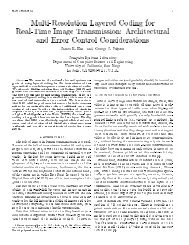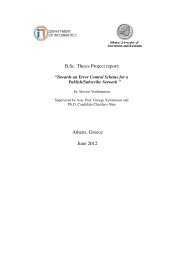In Network Processing and Data Aggregation in
In Network Processing and Data Aggregation in
In Network Processing and Data Aggregation in
You also want an ePaper? Increase the reach of your titles
YUMPU automatically turns print PDFs into web optimized ePapers that Google loves.
the r<strong>in</strong>gs topology. <strong>Aggregation</strong> proceeds level-by-level, with level i + 1 nodestransmitt<strong>in</strong>g, while level i nodes are listen<strong>in</strong>g. <strong>In</strong> contrast to trees, the r<strong>in</strong>gs topologyexploits the wireless broadcast medium by forc<strong>in</strong>g all level i nodes that hear a level i + 1partial result, to <strong>in</strong>corporate that result <strong>in</strong>to their own. <strong>In</strong> that way, there is a significant<strong>in</strong>crease <strong>in</strong> robustness, because each read<strong>in</strong>g is accounted for <strong>in</strong> many paths towards thebase station, <strong>and</strong> all would have to fail for the read<strong>in</strong>g so as not to be accounted for <strong>in</strong> thequery result. As with trees, nodes can monitor l<strong>in</strong>k quality <strong>and</strong> level changes aswarranted. A key advantage of us<strong>in</strong>g a r<strong>in</strong>gs topology is that the communication error istypically very low, <strong>in</strong> stark contrast with trees. Moreover, the r<strong>in</strong>gs approach is as energyefficientas the tree approach (with<strong>in</strong> 1%). Nevertheless, because each partial result isaccounted for <strong>in</strong> multiple other partial results, special techniques are required to avoiddouble-count<strong>in</strong>g.<strong>Aggregation</strong> PhaseThe aggregate computation is def<strong>in</strong>ed by three functions on thesynopses:• Synopsis Generation:A synopsis generation function SG(arg) takes a sensor read<strong>in</strong>g(<strong>in</strong>clud<strong>in</strong>g its metadata) <strong>and</strong> generates a synopsis represent<strong>in</strong>g thatdata.• Synopsis Fusion:A synopsis fusion function SF(arg1, arg2) takes two synopses <strong>and</strong>generates a new synopsis.• Synopsis Evaluation:A synopsis evaluation function SE(arg) translates a synopsis <strong>in</strong>to thef<strong>in</strong>al answer.The exact details of the functions SG(), SF(), <strong>and</strong> SE() depend on theparticular aggregate query to be answered.Dur<strong>in</strong>g the aggregation phase, each node periodically uses the function SG() <strong>in</strong> orderto convert sensor data to a local synopsis <strong>and</strong> the function SF() so as to merge twosynopses to create a new local synopsis. For example, whenever a node receives asynopsis from a neighbour, it may update its local synopsis by apply<strong>in</strong>g SF() to itscurrent local synopsis <strong>and</strong> the received synopsis. F<strong>in</strong>ally, the query<strong>in</strong>g node uses the








